Latest News
For those of our members who are registered with the Engineering Council (EC) as CEng, IEng or EngTech through the Society of Environmental Engineers (SEE), you will have received correspondence advising you that SEE will no longer be a Licenced Member of the EC after 31 July 2019, and therefore ICorr Members will no longer be able to use this route for Registration.
Providing Registrants have paid their 2019 Registration fees and are up to date with ICorr subscriptions, their registration will continue until 31 July 2020 so there is no need for concern. We will have alternative arrangements in place before then.
We are in the process of setting up a Registration Agreement with another Licenced Member of the EC which has been approved by both councils and is now subject to approval by Engineering Council. Once approved, some of our procedures will have to change but the important thing for ICorr is that we will be able to continue to offer Registration to our members in a seamless way.
For those members who are thinking of applying for Registration, can we ask you to continue completing the forms and gathering your information together but please hold onto your application until we are able to announce an alternative route to Registration, hopefully at the start of 2020.
Please be patient and as soon as we have an agreement in place, we will inform you of the changes and the procedure for transferring your Registration from SEE to the new Licenced Member.
Urgent Requirement
To all those Members that are registered as CEng, regardless of which body you may be registered through, ICorr needs a pool of willing volunteers to act as applicant assessors and professional review interviewers to ensure that the applicant meets the requirements of EC’s UKSpec. Suitable training will be provided.
It is estimated that you would not have more than 4 applications per annum to assess, averaging up to 3 hours per application. If willing to act as an interviewer, then this may be 2 or 3 half days per annum in London.
Any existing CEng willing to be considered for this role should let me know through ICorr Office (admin@icorr.org) as soon as possible so that training can be arranged. Please contact me should you require any further information concerning this role.
If we are unable to find and train sufficient assessors and interviewers, ICorr may lose the ability to offer registration. Formal assessment of potential new Registrants is an important function that is highly valued by the Institute and its members.
David Harvey, CEng, FICorr, EC Registration
Co-ordinator
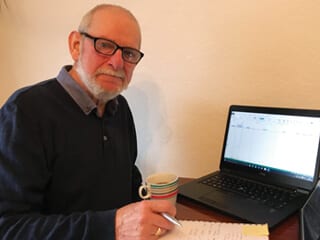
Latest News
Welcome to the latest issue of Corrosion Management. This is the third anniversary of my taking over as editor, and I hope you’ll enjoy reading the excellent technical articles I have lined up. These are truly global articles, including a detailed report on research into treating steel contaminated with sulphides prior to maintenance coating from experts at AkzoNobel in Canada. There is also a report on a new approach to evaluating the development of corrosion on steel from researchers at Argonne laboratories in the USA. Finally there is discussion, and case study, on how to supply current for cathodic protection on remote areas,
from France.
As usual, if you have any suggestions/comments on the articles published, or wish to submit an article or news item for a future issue, I can be contacted at
brianpce@aol.com
Brian Goldie, Consulting Editor
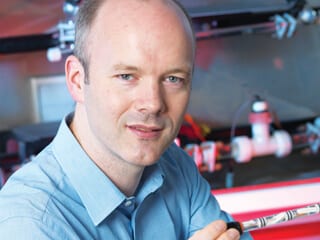
Latest News
t has been a busy summer for the Institute and I hope this issue of Corrosion Management gives you an idea of the number and variety of interesting activities that are bubbling away at the moment. It’s an exciting time to be involved! I have to say that I am thoroughly enjoying my time as President, which is made so much easier by the number of dedicated and enthusiastic volunteers who run the Institute activities, as well as our excellent and highly professional office staff.
I recently attended the EuroCorr conference in Sevilla and was delighted to be present at the awards ceremony to see Liane Smith receiving her EFC Honorary Fellowship. Liane gave an inspirational acceptance speech in which she emphasised to younger people in the audience the benefits of getting involved in both technical and professional committee activities. This is a top priority, not only for the Institute but for the corrosion profession in general, and I would strongly encourage our younger members to put themselves forward for these roles.
I would like to thank those of you who took the time to give us your views on the proposed refresh of the Institute brand. There were over 300 responses to the online survey, and of the three candidate brandmark/logo combinations, a clear preference has emerged amongst the membership. This has now been taken forward to the detail stage and the final brand assets will be rolled out to the website, stationery and marketing material during the autumn. While it is never possible to please everyone, we have been very much encouraged by the level of approval from our members.
One of the most rewarding aspects of being President is recognising the achievements of our members and others in the wider corrosion community. It was a privilege to present our two premier awards during the Electrochem 2019 conference in Glasgow, with Prof. Tetsuo Shoji receiving the 2019 U.R. Evans Award and Dr Steve Paterson accepting the 2019 Paul McIntyre Award. It was a particular pleasure to present the Paul McIntyre Award, having worked with Paul at NPL for many years. He was a true gentleman and the embodiment of dedicated and loyal service for the public benefit.
The Electrochem conference itself was a huge success and included for the first time a joint meeting between the Corrosion Science Symposium and the Corrosion Engineering Division Annual Working Day. It was great to see the students mixing with experienced corrosion engineers to exchange knowledge and make connections – this is certainly something that we would like to see more of in the future.
I’m pleased to say that we have recently simplified the ICorr membership application process. It is now possible for non-members to apply directly for Technician, Professional or Fellow membership, without the need to join as an Individual member first. Updated application forms and guidance notes are now available on the ICorr website. Please have a think about who you might prod – new members are always very welcome!
Finally, the date and venue for this year’s AGM have been confirmed. The meeting will take place in the Council Chamber at Birmingham Council House in conjunction with the Midland Branch meeting on the afternoon of Thursday 31st October. Several interesting and entertaining technical talks have been arranged and I would encourage you all to mark the event in your diaries.
Icorr President, Gareth Hinds
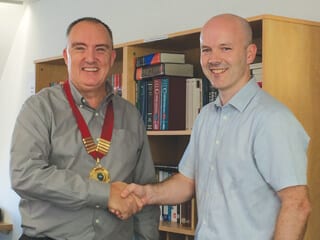
New Vice President Bill Hedges receives his Regalia from President Gareth Hinds at the recent Council meeting.
Latest News, London Branch
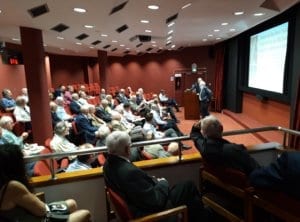
John T O’Shea Chairing the meeting
This Season’s 1st Technical Meeting of the London Branch was held on Thursday 26th September. This was a Joint Meeting with the Society of Chemical Industry (SCI) at their Headquarter’s newly refurbished auditorium in Belgravia. By coincidence, this was the location where ICorr S&T was formed and was the base of the Headquarters for a number of years. The late David Deacon also had offices here. The audience of over 70, included Professor Ken Grattan, OBE, FREng, who is the Dean of the Graduate School at City, University of London and who agreed to give the Vote of Thanks. Also present was Gareth Hinds of NPL, President of ICorr and Dr Richard Morrison, President of BeBC.
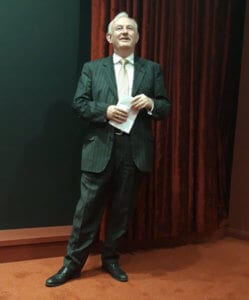
Professor Ken Grattan, OBE, FREng
The Evening Chairman, John T O’Shea, introduced Dr Fred Parrett, Hon Treasurer of the SCI London Group, who gave the first presentation on the laying of the first Transatlantic Telegraph Cables.
The electric telegraph was first developed by Samuel F. B. Morse, in 1832, who developed Morse Code. Land based cables to use the telegraph soon followed, and within a decade, more than 20,000 miles of telegraph cable criss-crossed the USA and the UK and Europe. Trials of underwater cable were undertaken by Samuel Morse across New York Harbour in 1842 and Charles Wheatstone across Swansea Bay in 1844. In 1851 a cable crossed the English Channel.
The problems of laying a cable across the Atlantic were a greater challenge, not just the technical and logistical problems, but financing such a great undertaking. The first attempt in 1857 failed when the cable broke, and could not be recovered. New finance was arranged and in Aug 1858 they succeeded, when the first transatlantic telegraph message was transmitted. Unfortunately the cable failed after only three weeks, it is thought due to breakdown of the cable insulation when voltages of a few thousand volts were used to try and speed up transmission speed.
It took another 7 years before new finance was arranged and improved cable designs were developed for the next attempt. For this Brunel’s ship the Great Eastern was acquired, the largest ship in the world, In 1865 it almost succeeded, starting in Valentia Bay , Ireland it reached 600 miles from Newfoundland when the cable again broke. The final success came one year later in August 1866 when the cable finally crossed the Atlantic and permanent telegraph communication established. The 1866 transatlantic cable could transfer 8 words a minute, and initially it cost $100 to send 10 words. $100 translates to about $1,340 today, mainly used by the British and American governments and large corporations.
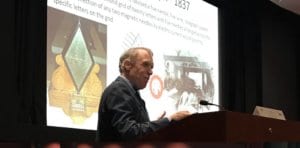
Dr Fred Parrett giving presentation on the laying of the first Transatlantic Telegraph Cables
The second presentation was given by Trevor Osborne, a Past President of ICorr and a Past Chairman of London Branch, on 50 Years of Oil and Gas Offshore Corrosion Control Experience and Transfer of Technology to Offshore Renewables.
Development of offshore structure corrosion control in the North Sea, and all around the world, has been on going for decades, in fact close to 50 years and possibly longer in some parts. Given this long experience corrosion engineers rightly considered that all aspects of barrier coatings and cathodic protection were honed to a fine art and as a result one system followed another with great success, in fact Trevor has been involved in many offshore structure designs with responsibility for painting, coating, CP, biocides, inhibitors and other aspects of corrosion control. However the fabrication and installation of new offshore structures in the oil and gas market has declined greatly and that work load has in part been replaced by the upsurge in renewable energy requirements. Specifically the replacement workload has been in offshore wind generation in the form of monopiles, transition pieces and substation fixed jackets. All exposed parts of each structure need to be addressed from a corrosion perspective if the asset is to be protected and the lifetime met.
The presentation walked through the period of time from early offshore structure design and construction for the oil and gas markets to the painful transition to wind energy, including the attendant problems that have occurred along the way and what should have been an easy transformation but often times was not.
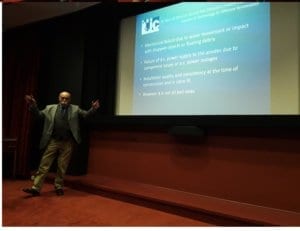
Trevor Osborne giving presentation on 50 Years of Oil and Gas Offshore Corrosion Control Experience and Transfer of Technology to Offshore Renewables.
Cathodic protection,using impressed current systems have proved to be the most suitable and effective method of corrosion protection. This is now the preferred system for all off-shore wind farm constructions.
Aberdeen Branch, Latest News
The ICorr Induction presentation was performed in September 26th at Aberdeen University by Zahra Lotfi, who is currently Aberdeen ICorr Branch (University Liaison and CPD Officer). This event was excellently organised and the related flyers were circulated well in advance with the support of Aberdeen University, with 35 Students attending on the day.
Dr. M. Amir Siddiq of the School of Engineering, kindly supported ICorr to schedule the Induction Talk just after his Subsea Integrity lecture. This co-operation between ICorr and Aberdeen University resulted in a brilliant turn out of new MSc students, as well as many returning students.
The presentation commenced with introduction to corrosion, corrosion cost, the importance of corrosion control/ mitigate/ monitor, consequents of corrosion with several real life examples of catastrophic failure due to corrosion in oil and gas and transportation, common corrosion degradation mechanisms in oil and gas and the co-operation of different engineering disciplines who can provide the integrity of an asset.
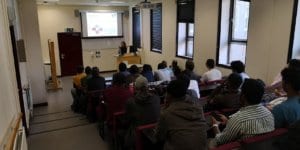
Photo: Presentation by Zahra Lotfi, (University Liaison and CPD Officer) to Aberdeen University Students on 26/09/2019.
The students were introduced to the Institute of Corrosion, its objectives, technical divisions, regional branches, trainings and qualifications provided by ICorr and the many benefits of ICorr membership (e.g. ICorr mentoring program to assist its members to achieve their Chartered Status) and how to apply for ICorr membership.
In addition, the students were familiarised with the work of Aberdeen ICorr branch, the activities calendar, its website and how the institute can assist students greatly in their continuous Professional Development (CPD).
At the Finale, questions on ICorr membership, chartered engineering requirements and local events were discussed in detail. It later continued with a further Q&A session while the students were enjoying eating Pizza provided by Aberdeen ICorr Branch.
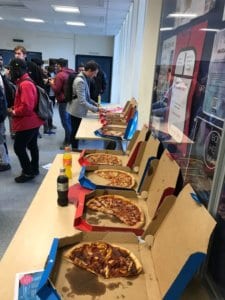
Photo: Students enjoy ICorr Catering at Aberdeen University Presentation of 26/09/2019.
Future collaboration events between Aberdeen University School of Engineering and ICorr were also discussed with Dr. M. Amir Siddiq and Dr.Henry Tan.
Great ideas and thoughts were offered by Dr. Yunnan Gao (Immediate Past Chair) on how the students can involve themselves in ICorr activities e.g. by way of a poster presentation or to present their research project in greater detail, at upcoming Aberdeen ICorr Events.
Further details may be found at:
Past Technical Presentation Slides: https://sites.google.com/site/icorrabz/resource-center
Photo Gallery for the Past Events: https://sites.google.com/site/icorrabz/event-gallery






